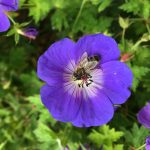Irish farmers growing strawberries, tomatoes, apples or oilseed rape know…
Blooming Bees: The All-Ireland Pollinator Plan
One third of our bee species are threatened with extinction from Ireland. We know it’s because we have drastically reduced the areas where they can nest and the amount of food (flowers) our landscape provides for them. We can stand back and watch the problem happen, or we can try to do something.
The All-Ireland Pollinator Plan is about all of us, from farmers to local authorities, to schools, gardeners and businesses, coming together to try to create an Ireland where pollinators can survive and thrive.
The plan provides an important framework to bring together pollinator initiatives from the North and South, and is the start of a process by which we can collectively take positive steps to protect our pollinators and the service they provide into the future.
It is a shared plan of action. By working together we can reverse pollinator losses and help restore populations to healthy levels. Over the next five years this Plan aims to build a foundation to bring about a landscape where pollinators can flourish.
For more see http://pollinators.ie
This animation was funded by Kildare County Council and Wicklow County Council’s Creative Ireland programme.







